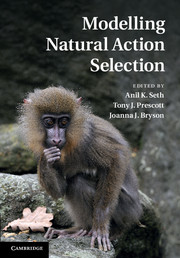Book contents
- Frontmatter
- Contents
- Foreword
- Preface
- Contributors
- 1 General introduction
- Part I Rational and optimal decision making
- Part II Computational neuroscience models
- 9 Introduction to Part II: computational neuroscience models
- 10 Action selection and refinement in subcortical loops through basal ganglia and cerebellum
- 11 Cortical mechanisms of action selection: the affordance competition hypothesis
- 12 Toward an executive without a homunculus: computational models of the prefrontal cortex/basal ganglia system
- 13 Hierarchically organised behaviour and its neural foundations: a reinforcement-learning perspective
- 14 The medial reticular formation: a brainstem substrate for simple action selection?
- 15 Understanding decision-making deficits in neurological conditions: insights from models of natural action selection
- 16 Biologically constrained action selection improves cognitive control in a model of the Stroop task
- 17 Mechanisms of choice in the primate brain: a quick look at positive feedback
- Part III Action selection in social contexts
- Index
- Plate section
- References
17 - Mechanisms of choice in the primate brain: a quick look at positive feedback
from Part II - Computational neuroscience models
Published online by Cambridge University Press: 05 November 2011
- Frontmatter
- Contents
- Foreword
- Preface
- Contributors
- 1 General introduction
- Part I Rational and optimal decision making
- Part II Computational neuroscience models
- 9 Introduction to Part II: computational neuroscience models
- 10 Action selection and refinement in subcortical loops through basal ganglia and cerebellum
- 11 Cortical mechanisms of action selection: the affordance competition hypothesis
- 12 Toward an executive without a homunculus: computational models of the prefrontal cortex/basal ganglia system
- 13 Hierarchically organised behaviour and its neural foundations: a reinforcement-learning perspective
- 14 The medial reticular formation: a brainstem substrate for simple action selection?
- 15 Understanding decision-making deficits in neurological conditions: insights from models of natural action selection
- 16 Biologically constrained action selection improves cognitive control in a model of the Stroop task
- 17 Mechanisms of choice in the primate brain: a quick look at positive feedback
- Part III Action selection in social contexts
- Index
- Plate section
- References
Summary
Summary
The mammalian brain's decision mechanism may utilise a distributed network of positive feedback loops to integrate, over time, noisy sensory evidence for and against a particular choice. Such loops would mitigate the effects of noise and have the benefit of decoupling response size from the strength of evidence, which could assist animals in acting early at the first signs of opportunity or danger. This hypothesis is explored in the context of the sensorimotor control circuitry underlying eye movements, and in relation to the hypothesis that the basal ganglia serve as a central switch acting to control the competitive accumulation of sensory evidence in positive feedback loops representing alternative actions. Results, in support of these proposals, are presented from a systems-level computational model of the primate oculomotor control. This model is able to reproduce behavioural data relating strength of sensory evidence to response time and accuracy, while also demonstrating how the basal ganglia and related oculomotor circuitry might work together to manage the initiation, control, and termination of the decision process over time.
Introduction
Whether it is a cheetah deciding whether its prey is veering left or right, a rabbit deciding whether that movement in the bushes is friend or foe, or a poker player wondering if his opponent has a stronger hand, infinitesimally small variations in sensory input can give rise to vastly different behavioural outcomes: the cheetah veers left and not right, the rabbit flees or continues grazing, the card player bets a month's salary or folds. The outcome of such decisions can be critical, even a matter of life or death, which is why there will have been tremendous evolutionary pressure to develop decision-making mechanisms that can extract maximal utility from limited sensory information. In this chapter, using the oculomotor system as an exemplar, we argue that the vertebrate basal ganglia (BG) are one of the results of that evolutionary pressure and explore how these structures tame and exploit positive feedback loops (henceforth PFBLs) within the brain in order to make the most of limited information.
- Type
- Chapter
- Information
- Modelling Natural Action Selection , pp. 390 - 418Publisher: Cambridge University PressPrint publication year: 2011
References
- 2
- Cited by



